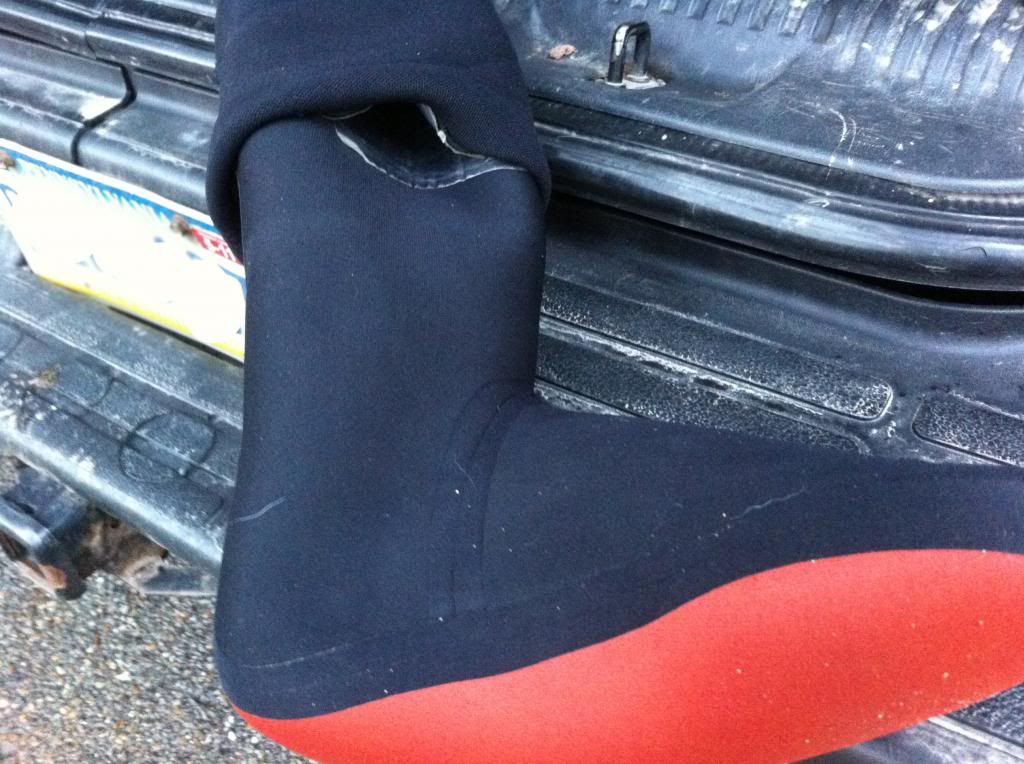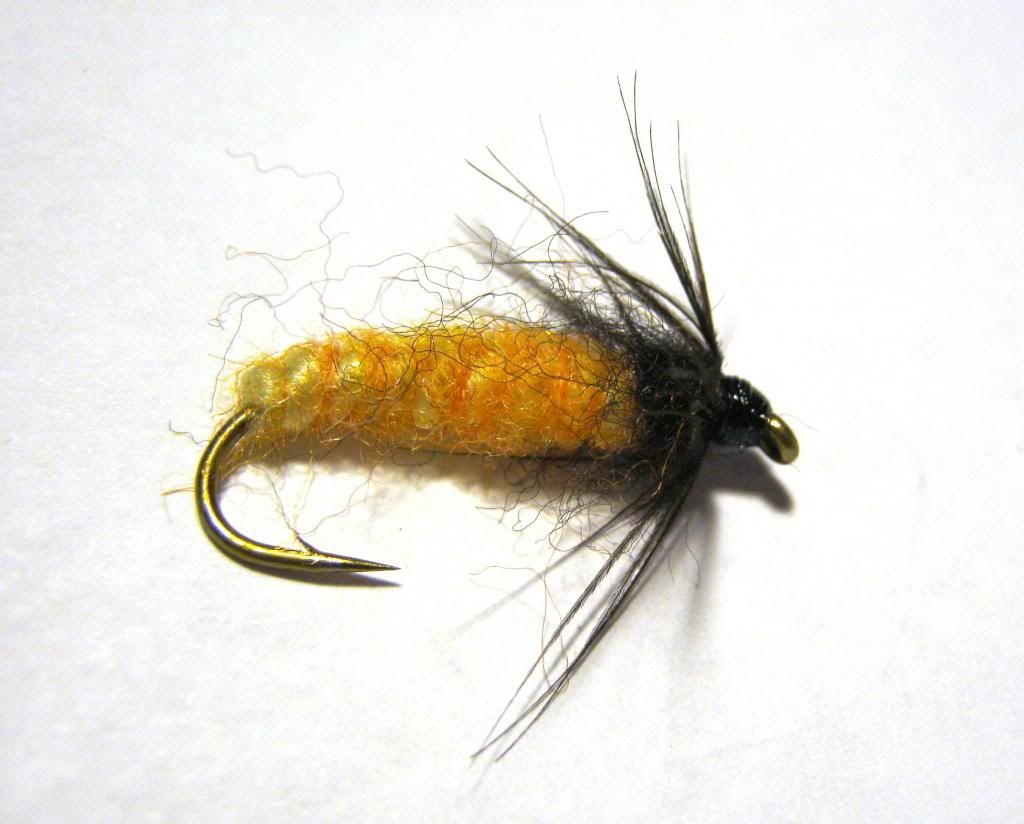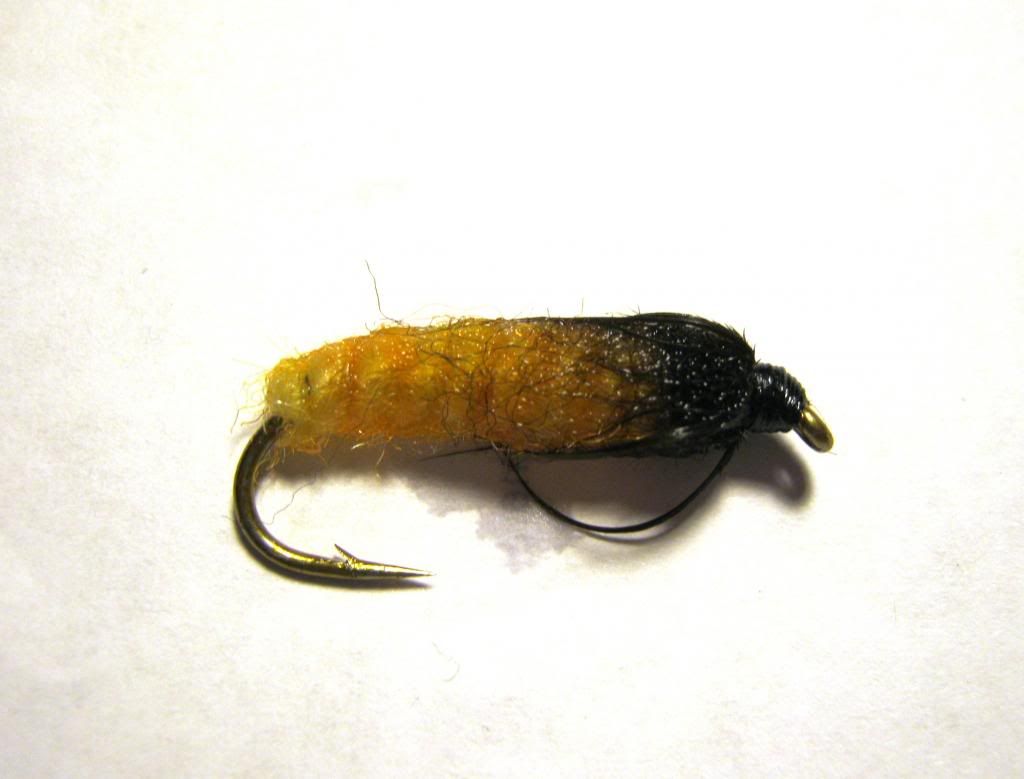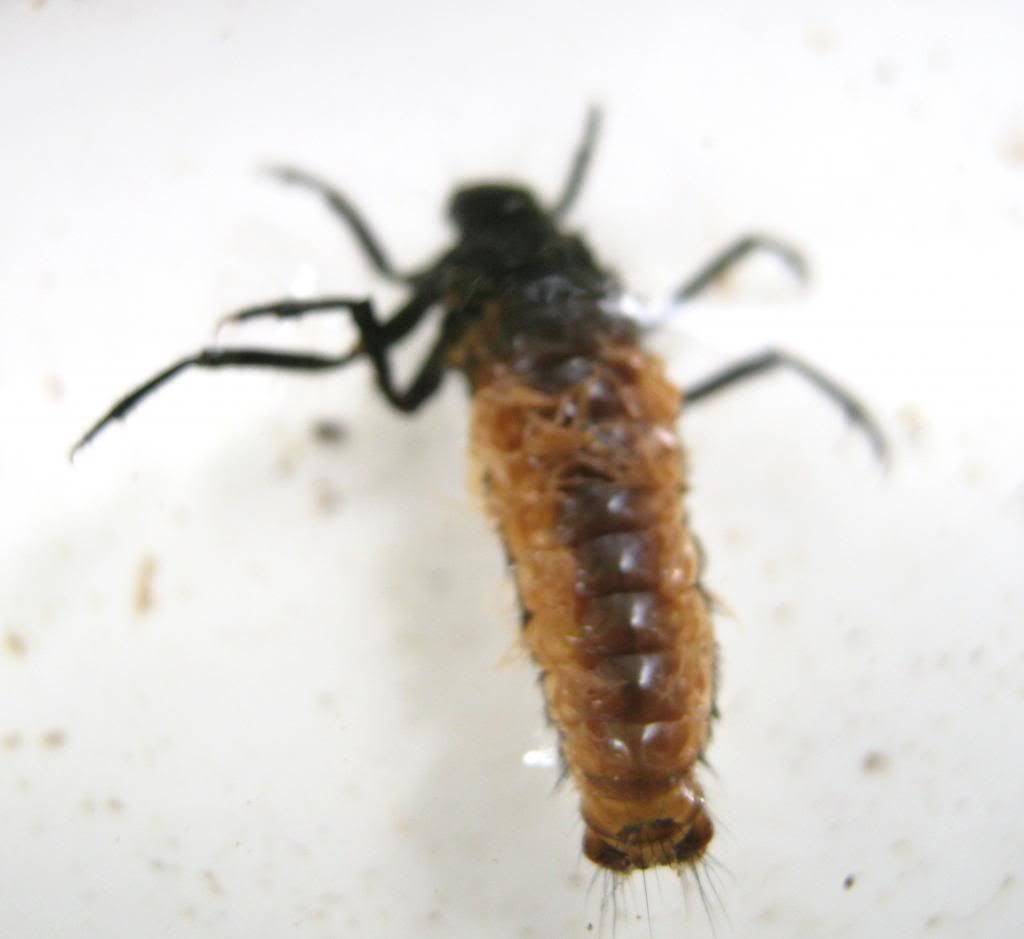Blog & Latest Updates
Fly Fishing Articles
Insects by Common Name


> > Rubber Band Caddis
| FisherOfMen | March 8th, 2012, 10:09 pm | |
| NY Posts: 115 | Does anyone have any experience with the rubber band caddis? It looks like a pretty good nymph, and seems very easy to tie. I have plenty of rubber bands lying around so I think I'll give it a go one of these days. Rubber Band Caddis: http://www.youtube.com/watch?v=e-HBKIzqcyQ&NR=1&feature=endscreen | |
| "Nothing makes a fish bigger than almost being caught." -Author Unknown All that is necessary for the triumph of evil is that good men do nothing. -Edmund Burke | ||
| Softhackle | March 8th, 2012, 10:58 pm | |
Site Editor Wellsville, NYPosts: 540 | Here's my version, and it has worked well for me. I do not add weight, and it still works. I've been tying and using it for years. Mark http://www.danica.com/FLYTIER/mlibertone/rubber_band_worm.htm | |
| "I have the highest respect for the skilled wet-fly fisherman, as he has mastered an art of very great difficulty." Edward R. Hewitt Flymphs, Soft-hackles and Spiders: http://www.troutnut.com/libstudio/FS&S/index.html | ||
| Sayfu | April 1st, 2013, 6:34 pm | |
| Posts: 560 | I am tying a midge pupa with "tenacles" that are of the flex floss variety. I am still shell shocked by the rubber legs I used on some big stonefly patterns. They were destroyed in my flybox. I had to throw out a good number of patterns because heat, or something else destroyed the round rubber legs. The commercial tier I just watched tie on Sat. said the same thing happened to him. He is a guide as well, and when I brought it up he knew exactly what I was talking about. | |
| Entoman | April 1st, 2013, 8:18 pm | |
| Northern CA & ID Posts: 2604 | Jere, I feel your pain... I long ago gave up tying with latex sheeting and rubber legs. I have a whole box of reject deer hair Hoppers and stoneflys from years ago. The legs are so brittle that they fall to pieces by just handling them. Latex? I remember in the seventies, when Boaz first poularized its use for caddis larvae. Cool looking stuff! Had a whole box of them that I relied on from time to time for many years. One day I opened the box and half of them had melted into a black gooey mess. The process happened pretty quickly once started, perhaps only a few months? They looked fine the previous time I remembered looking at them. The pain of cleaning out that small clip Wheatley only added insult to injury. For legs and such, Stick with silicone and Spandex or Lycra (flexi floss), they won't let you down. For shell-backs on the popular Czech style nymphs (and especially scuds) I prefer the plastic used for keeping your Cheerios fresh. It is slightly dull and takes marker well. I know competition anglers prefer latex, but they are fishing in this style a lot more than most of us and their selections don't last long enough to worry too much about this. Regardless, I've never felt handicapped by my preference. Bottom line, unless flyfishers are OK with throwing out boxes of flies every couple of years (or cleaning gooey messes if they wait too long), stay away from the stuff. | |
| "It's not that I find fishing so important, it's just that I find all other endeavors of Man equally unimportant... And not nearly as much fun!" Robert Traver, Anatomy of a Fisherman | ||
| Gutcutter | April 2nd, 2013, 12:40 pm | |
| Pennsylvania Posts: 470 | Latex? I remember in the seventies... What I remember about latex and the 70's was the fact that I no longer had to wear heavy boots sewn to the bottom of my leaky waders. I bought a pair of... SealDri latex waders I wore them with a pair of socks and an oversized pair of Chuck Taylor's. By the time I was done with them, they were probably more pliobond than latex. I then went to the best (driest) waders I ever put on- RedBall nylons. They rolled up smaller than the boots! I wore those until 1993 when I paid the outrageous price of $149 for my first Simms (that were actually made in Montana). I retired those in 2007 and bought new Simms that aren't made nearly as well. | |
| All men who fish may in turn be divided into two parts: those who fish for trout and those who don't. Trout fishermen are a race apart: they are a dedicated crew- indolent, improvident, and quietly mad. -Robert Traver, Trout Madness | ||
| Crepuscular | April 2nd, 2013, 12:58 pm | |
| Boiling Springs, PA Posts: 923 | I retired those in 2007 and bought new Simms that aren't made nearly as well. Sorry for the hijack...I bought a new pair of G3 last month. this what they look like now. That hole is NOT supposed to be there.  | |
| Woger | April 2nd, 2013, 5:05 pm | |
| Posts: 3 | This is a great looking pattern that uses latex. https://vimeo.com/32901072 | |
| Sayfu | April 2nd, 2013, 5:10 pm | |
| Posts: 560 | Back to the rubber band caddis, and Fisher's question. If that is the latex wrapped abdomen caddis pupa, or larva that has the nice looks/segmentation appearance, I can report that Mike Lawson points out this creation, to be a good looking pattern he accepted years ago only to find out it doesn't catch fish!! I listened to Mike give a talk on this very pattern, and one he would never use again! | |
| Roguerat | April 2nd, 2013, 5:24 pm | |
| Posts: 472 | This brings back very bad memories from my bait-casting days, opening the tackle-box to find masses of slime where the spinner-bait and jig skirts were supposed to be. cut to today, and I'm using silicone for the above-mentioned Caddis-body, among other nymph patterns. It comes in some fairly natural colors and seems to be impervious to ultra-violet and anything else that was death to latex. Heading out this week, the Little Black Stoneflies are on and forecast is for fair weather. The Roguerat I Peter 5:7 'Cast your cares upon Him...' | |
| Entoman | April 2nd, 2013, 11:09 pm | |
| Northern CA & ID Posts: 2604 | I can report that Mike Lawson points out this creation, to be a good looking pattern he accepted years ago only to find out it doesn't catch fish!! Well, I don't know if I'd fully agree with that assessment, as I did catch fish with mine; but what is undeniable (at least to me) is that latex larvae certainly never proved to be superior to dubbed bodies. So, why put up with the nasty attributes? I've found that the Czech style works best for the net-spinners (Hydropsychidae). Twisted synthetic yarn bodies get the nod in my book for free-livers (Rhyacophilidae) and some large cased caddis that abandon their shelters on occasion. Dicosmoecus (October Caddis) is a good example of the latter. There are some favorite small creeks (that shall go unnamed) in the upper Hat Creek drainage that fish very well in the early Summer high-sticking with such patterns. Their surprisingly large native Red Bands really like 'em. Tightly twisted yarn simulates the segmented bodies very well. The only problem is most yarns are pretty monochromatic. A neat trick is to separate the plies and incorporate a little contrasting/complimentary dubbing; really turning the yarn into a dubbing loop. The effect when twisted back up is pretty cool. My favorite for Dicosmoecus is plain pale yellow Antron or Orlon 3 ply with a dash of hot orange and a little creamy tan Buggy Nymph. Antron yarn with the clear sparkly fibers is too much for my tastes to simulate larvae, but it would probably work fine. I experimented with brown shell backs but found they were less effective. Perhaps because they detract from the segmentation? Anyway, no need to get too anatomic with flies fished in the rock gardens.:) You go through quite a few if you're fishing them right. Here's some photos to illustrate the result of the technique. The second photo shows the fly wet. I think the juicy looking multicolored segmentation is a real trigger. The result is quite life-like for a simple dressing. The fish seem to agree. BTW - this fly is fairly heavy with two layers of flat lead underneath. Hi-Stick Larva (October Caddis) #6    | |
| "It's not that I find fishing so important, it's just that I find all other endeavors of Man equally unimportant... And not nearly as much fun!" Robert Traver, Anatomy of a Fisherman | ||
| Sayfu | April 3rd, 2013, 8:44 am | |
| Posts: 560 | That is a good looking pattern, and one I will tie up. And that latex caddis is the only pattern I've ever heard Mike describe as ineffective. He may have even included it in his book. | |
| Crepuscular | April 3rd, 2013, 8:48 am | |
| Boiling Springs, PA Posts: 923 | Once again Kurt, very nice fly. As far as the latex goes as previously stated the abundance of other materials that provide that segmentation that actually recreate it better than the ribber band, make the rubber band in my opinion seem like a good thought at first but not a viable material for fly construction. | |
| Entoman | April 4th, 2013, 8:12 pm | |
| Northern CA & ID Posts: 2604 | Thanks, guys. Waders aside, the rest of the conversation is a bit of a highjack as well. I was primarily addressing the issue of quickly degrading materials raised by Jere and steered it away from Nick's original question. Degredation is probably not as big a problem with rubber bands used for fly bodies. As to their effectiveness, my agreement with Eric has prevented me from experimenting with them much. Mark's example clearly works for him, or he wouldn't have provided it. One advantage that he has mentioned before is that his fly sinks very well in spite of being unweighted, which is the way he prefers to tie and fish his flies. | |
| "It's not that I find fishing so important, it's just that I find all other endeavors of Man equally unimportant... And not nearly as much fun!" Robert Traver, Anatomy of a Fisherman | ||
| PaulRoberts | April 11th, 2013, 12:41 am | |
| Colorado Posts: 1776 | Well..since hijackers are running amuck... My very first fly was a rubber band wound around a #6 baitholder and secured with thread. I threw it out there on my Dad's old tubular steel baitcaster and let it soak. And I caught a carp on it! My biggest fish to date, as of 1969. OK, to get back closer to the topic ... I always wanted to make a neoprene fly from an old pair of waders. | |
| Sayfu | April 11th, 2013, 9:53 am | |
| Posts: 560 | Please let me copy an excerpt from Mike Lawson's incredible book "Spring Creeks" "I have seen many fads with fly-tying materials over the years. One was wrapping latex material on the hook shank to imitate free-living caddis larvae. I tied a good number of latex caddis larvae, and eagerly fished them whenever I had a chance, but my results were extremely disappointing. Latex didn't work. When I used the latex fly, and a caddis larva tied with a body of bright, antron dubbing in with a two-fly setup, the other fly out-fished the latex twenty to one. Latex was just an example of man's trying to imitate trout food the way he sees it instead of the way it is believed to be visualized by the trout." | |
| Entoman | April 11th, 2013, 2:46 pm | |
| Northern CA & ID Posts: 2604 | I agree with that assessment for spring creeks. What catches I made with them were in waters moving at a pretty good clip (Upper Sac, etc.)....an example of man's trying to imitate trout food the way he sees it instead of the way it is believed to be visualized by the trout." Yes. I have a theory that this is largely due to our view of flies in the hand as opposed to perceiving things differently. Macro-photography has exposed the reason for this. Dull monochromatic flies without texture may look okay from a distance, but up close the way trout see them? I think the above photos speak for themselves... | |
| "It's not that I find fishing so important, it's just that I find all other endeavors of Man equally unimportant... And not nearly as much fun!" Robert Traver, Anatomy of a Fisherman | ||
Quick Reply
You have to be logged in to post on the forum. It's this easy:
Related Discussions
| Title | Replies | Last Reply |
| Re: Hareline Wiggle Dub In Fly Tying by Outdoors198 | 8 | Nov 23, 2015 by Planettrout |
| Re: Newbie In the Insect Order Trichoptera by GennieS | 2 | May 26, 2009 by Shawnny3 |
| Re: Early Season NE Stonefly patterns In Fly Tying by Vtbrowns57 | 4 | Apr 3, 2019 by Crepuscular |
| Polycentropodidae In Polycentropus Caddisfly Larva by Earlfishman | 0 | |
| Emergence In Brachycentrus appalachia Caddisfly Adult by Martinlf | 0 | |
| Re: Deer hair daddy long legs dry fly In Fly Tying by Coha | 1 | Jul 31, 2020 by Martinlf |
| Re: Wooly Worm Variation In Fly Tying by Bcvizina | 4 | Aug 10, 2010 by Heehee |
| Re: caddis flies In Brachycentrus appalachia Caddisfly Adult by Flytyer0423 | 2 | Aug 11, 2009 by GONZO |
| Re: I don't know how this slipped by me!!! In Fly Tying by Oldredbarn | 3 | Mar 20, 2013 by Sayfu |
| Re: trying to figure out In the Insect Family Corydalidae by Buggy | 1 | Apr 19, 2009 by GONZO |
Troutnut.com is copyright © 2004-2024 Jason
Neuswanger (email Jason). See my FAQ for information about use of my images.
 privacy policy
privacy policy







